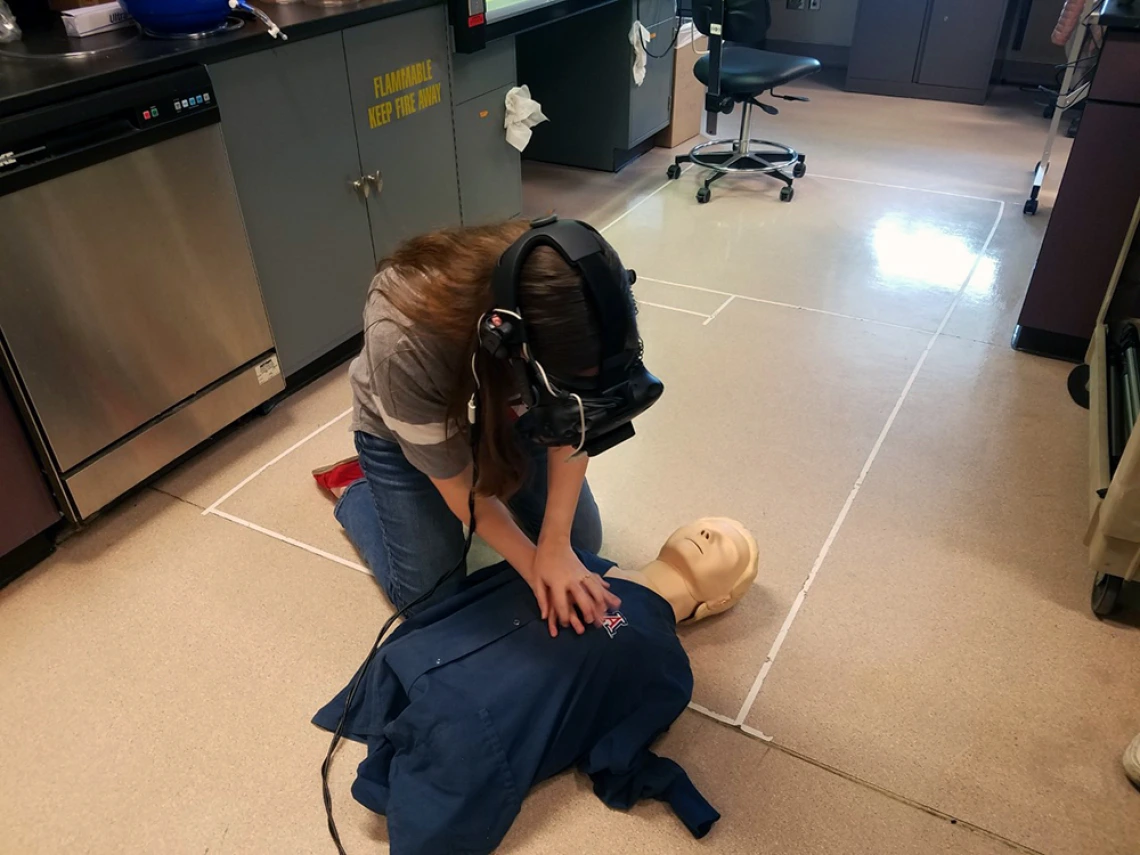W.L. Gore Supports Biomedical Projects

Hannah Bergeron of Team 18072 tests their design of a virtual reality CPR training system.
Project Title: Dynamic Bioreactor for Engineered Cartilage Tissue
Team 18066 Members:
Dallas Altamirano, biomedical engineering
Efren Barron, biomedical engineering
Sam Freitas, biomedical engineering
Xinyi Gu, electrical engineering
Danielle Larson, biosystems engineering
Trinny Tat, biomedical engineering
Project Title: Virtual Reality System for Realistic Cardiopulmonary Resuscitation Training
Team 18072 Members:
Hannah Bergeron, biomedical engineering
Jesse Gilmer, electrical and computer engineering
Gisselle Gonzalez, biomedical engineering
Brianna Hudson, biosystems engineering
Miguel Peña, biomedical engineering
Jimmy Tran, electrical and computer engineering
Sponsor: UA Department of Biomedical Engineering
Gore’s Long History With the College of Engineering
W.L. Gore & Associates has been a longtime friend of the College of Engineering. They sponsored Engineering Design Program projects for many years, and also sponsor the W.L. Gore & Associates prize for the most creative solution at Design Day. The company has made an annual gift since the 2013-2014 academic year to subsidize biomedical engineering capstone projects, and sponsors the freshman-year Solar Oven Throw Down.
“We feel that supporting things that enhance the student experience is really important,” said Ryan Gapp, current Gore college champion for the UA and a 2014 graduate of the university’s biomedical engineering program. “One of the things we really like is that this program focuses on the design effort in a team. At Gore, we generally work in small teams of about five to 10 people. By supporting this, we’re hoping the students get more of those skills that make them ready for the workplace — not just at Gore, but at other companies too.”
Teams 18066 and 18072, both working on biomedical projects that exemplify Gore’s values of teamwork, strong communication and creative problem-solving, are just two examples of the student groups the company’s gift supports.
Cartilage Cats
When cartilage in the human body is damaged, it doesn’t grow back. Scientists are investigating how to replenish lost cartilage through stem cells, or undifferentiated cells that haven’t developed a specific purpose. However, cartilage grown from stem cells isn’t as strong as cartilage in the human body because it’s not used to supporting weight. Team 18066 is developing a bioreactor that will place a load on the stem cells while they are developing into cartilage cells.
“Applying the load helps the stem cells choose to turn into cartilage cells, rather than something like a muscle cell,” said team lead and biomedical engineering major Dallas Altamirano. “It helps them align and interconnect like fibers with firmer membranes, so if you were to put the cells into a person, they would be used to feeling those loads.”
The team went through several designs before they found one that most closely replicated the way weight is borne by living tissue, and one of their biggest challenges has been determining how to measure strain on the tiny scaffolds that are host to the stem cells. But the team says the challenge is worth it.
“This is beneficial for basically anyone who has cartilage damage, whether it’s from disease or trauma,” Altamirano said.
Learning CPR in VR
Though CPR can be lifesaving, it has to be performed correctly to be effective. Team 18072 is developing a virtual reality system paired with a physical CPR dummy that will provide feedback to users on their CPR techniques.
“We envision that the device will have a training mode where you go through all the steps you would in a CPR class, like checking for responsiveness, checking a subject’s breathing and calling 911 or making sure someone else does,” said biomedical engineering major and team lead Gisselle Gonzalez. “Then, you go through compression simulation and have a debrief where you get feedback.”
They’re basing the system’s standards as closely as they can on the American Heart Association’s standards of 2- to 2.4-inch-deep chest compression at a rate of 100 to 120 per minute. Integrating a real-life CPR mannequin into the virtual reality system has been a challenge, as has creating software that can track hand movements to within 0.1 inches.
“This has a lot of potential to help a lot of people,” said biomedical engineering major Hannah Bergeron. “And I’ve never touched Leap Motion, the VR software we’re using, in my life. It’s been a good challenge to learn how to code.”

